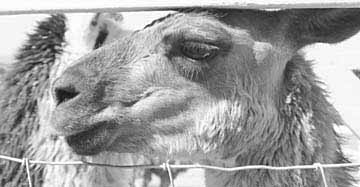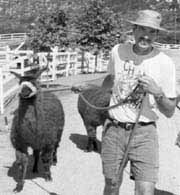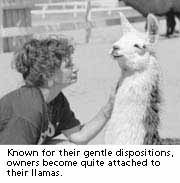







Llamas: not just another pretty face
by Keith Shillington and Joshua Galanter
 or 6,000 years llamas have been prized as strong, dependable
pack animals. Today, they are recognized for their minimal impact on the
environment, a calm and friendly disposition, and natural "trail sense."
All in all, llamas turned out to be the ideal solution for the Mubarak family.
or 6,000 years llamas have been prized as strong, dependable
pack animals. Today, they are recognized for their minimal impact on the
environment, a calm and friendly disposition, and natural "trail sense."
All in all, llamas turned out to be the ideal solution for the Mubarak family.
 The Mubaraks had been looking for a farm or ranch setting
to raise their children. They were looking for an environment with animals,
fruit orchards or something connected to the earth. The apple orchard in
Julian just wasn't quite it; nor was the avocado ranch in Valley Center.
The Mubaraks had been looking for a farm or ranch setting
to raise their children. They were looking for an environment with animals,
fruit orchards or something connected to the earth. The apple orchard in
Julian just wasn't quite it; nor was the avocado ranch in Valley Center.
Rural reconnaissance
 Traveling on business to South America in 1981, the
Mubaraks' itinerary included a nine-hour refueling layover in Lima, Peru.
Rather than hang around the airport, they decided to make it a three-day,
nine-hour layover, and signed up for a llama trip to the Inca ruins at Machu
Pichu. They quickly fell in love with the Indians' symbiotic relationship
with the animals.
Traveling on business to South America in 1981, the
Mubaraks' itinerary included a nine-hour refueling layover in Lima, Peru.
Rather than hang around the airport, they decided to make it a three-day,
nine-hour layover, and signed up for a llama trip to the Inca ruins at Machu
Pichu. They quickly fell in love with the Indians' symbiotic relationship
with the animals.
 Raising llamas: here was something very farm-like, which
would ultimately produce the desired atmosphere, a marketable product, and
didn't result in the slaughter of the animals. Perfect.
Raising llamas: here was something very farm-like, which
would ultimately produce the desired atmosphere, a marketable product, and
didn't result in the slaughter of the animals. Perfect.
 Rancho Machu Pichu was started by obtaining a single
female llama, and soon afterward, a second female llama. (llamas live in
packs, and it would be cruel to have only one). Well, both llamas were pregnant,
and now Rancho Machu Pichu has a "good production herd."
Rancho Machu Pichu was started by obtaining a single
female llama, and soon afterward, a second female llama. (llamas live in
packs, and it would be cruel to have only one). Well, both llamas were pregnant,
and now Rancho Machu Pichu has a "good production herd."
 Light on their feet
Light on their feet
 Llamas are environmentally friendly for several reasons,
one of which is the leathery padding on the bottoms of their feet. This
padding, much like a dog's paw, had less impact on a trail than the hooves
of most pack animals, or even a hiking boot. The padded foot also gives
the llamas exceptional stability and aids in weight distribution. These
soft feet don't detract from a llamas ability to carry a pack though; a
well trained llama will carry up to 30% of its body weight.
Llamas are environmentally friendly for several reasons,
one of which is the leathery padding on the bottoms of their feet. This
padding, much like a dog's paw, had less impact on a trail than the hooves
of most pack animals, or even a hiking boot. The padded foot also gives
the llamas exceptional stability and aids in weight distribution. These
soft feet don't detract from a llamas ability to carry a pack though; a
well trained llama will carry up to 30% of its body weight.
 Another attractive and unexpected feature of llamas
is their intelligence. The Mubaraks tell a story of one hiking trip with
llamas, where a strong, normally cooperative llama refused to cross a stream.
This particular animal had performed this particular crossing several times
in the past, but was absolutely refusing to go on. After much insistence,
the llama made the crossing, tumbling the boy holding his tether in the
process. It became clear that the llama knew that the tether was too short
to cross safely.
Another attractive and unexpected feature of llamas
is their intelligence. The Mubaraks tell a story of one hiking trip with
llamas, where a strong, normally cooperative llama refused to cross a stream.
This particular animal had performed this particular crossing several times
in the past, but was absolutely refusing to go on. After much insistence,
the llama made the crossing, tumbling the boy holding his tether in the
process. It became clear that the llama knew that the tether was too short
to cross safely.
 Llamas are a delight to hike with, as they are very
aware of their surroundings. The llamas will notice native creatures along
the path and by doing so will point them out to their human companions.
It is surprising how quickly a llama will sum up a trail situation and make
the right move.
Llamas are a delight to hike with, as they are very
aware of their surroundings. The llamas will notice native creatures along
the path and by doing so will point them out to their human companions.
It is surprising how quickly a llama will sum up a trail situation and make
the right move.
 Anther beneficial aspect of llamas is their efficient
digestive system. Efficient foragers, their prehensile lips grasp vegetation
without damaging plant roots, allowing it to quickly regenerate. All that
a packer needs is a pound or two of feed supplement and the llama takes
care of the rest. A llama's environmental impact is similar to that of the
native Mule Deer.
Anther beneficial aspect of llamas is their efficient
digestive system. Efficient foragers, their prehensile lips grasp vegetation
without damaging plant roots, allowing it to quickly regenerate. All that
a packer needs is a pound or two of feed supplement and the llama takes
care of the rest. A llama's environmental impact is similar to that of the
native Mule Deer.
 Llamas have a three-chambered stomach, similar to that
of a cow. This stomach is so efficient that the animal passes almost no
viable seeds. It is nearly impossible to introduce unwanted plants into
the wilderness via llama dung. When they're not on the trail, their small
odorless droppings (similar to elk droppings) are non-toxic and can be used
as fertilizer without curing. At Rancho Machu Pichu, they put them through
a shredder and directly onto the flower beds. Llamas also have the tendency
to leave their droppings in a communal dung heap, preventing the spread
of parasites and discouraging flies. These heaps are easily shoveled or
scattered, making cleanup easy for the owners.
Llamas have a three-chambered stomach, similar to that
of a cow. This stomach is so efficient that the animal passes almost no
viable seeds. It is nearly impossible to introduce unwanted plants into
the wilderness via llama dung. When they're not on the trail, their small
odorless droppings (similar to elk droppings) are non-toxic and can be used
as fertilizer without curing. At Rancho Machu Pichu, they put them through
a shredder and directly onto the flower beds. Llamas also have the tendency
to leave their droppings in a communal dung heap, preventing the spread
of parasites and discouraging flies. These heaps are easily shoveled or
scattered, making cleanup easy for the owners.
 Quiet on the trail
Quiet on the trail
 Llamas are very quiet on the trail and don't disturb
the native animals. It is unlikely that most wild animals have ever seen
a llama, and are rarely frightened by one. Llamas usually are vaccinated,
and are unlikely to introduce a disease into a wild population. In fact,
it is more likely that a wild animal will infect a llama.
Llamas are very quiet on the trail and don't disturb
the native animals. It is unlikely that most wild animals have ever seen
a llama, and are rarely frightened by one. Llamas usually are vaccinated,
and are unlikely to introduce a disease into a wild population. In fact,
it is more likely that a wild animal will infect a llama.
 The calm and gentle personality llamas possess make
them ideal for anyone to handle. They are friendly, intelligent and highly
social and inexpensive to maintain, costing less to feed than a dog. Those
looking for an exceptional pack animal that's economical to maintain and
environmentally friendly need look no further than the llama, a well-kept
secret for 6,000 years.
The calm and gentle personality llamas possess make
them ideal for anyone to handle. They are friendly, intelligent and highly
social and inexpensive to maintain, costing less to feed than a dog. Those
looking for an exceptional pack animal that's economical to maintain and
environmentally friendly need look no further than the llama, a well-kept
secret for 6,000 years.

Joshua Galanter is currently an engineering student at Stanford University.
Keith Shillington is an author and lecturer. Both express their commitment
to the environment by volunteering with San Diego Earth Day.

Llama, fiber of the future?
 "Llama fiber." You or I might call it llama
fur, hair or wool. Whatever it's called, it can be used in a wide range
of products, from biodegradable flower pots (instead of the vanishing resource,
peat moss) to hats, vests and sweaters.
"Llama fiber." You or I might call it llama
fur, hair or wool. Whatever it's called, it can be used in a wide range
of products, from biodegradable flower pots (instead of the vanishing resource,
peat moss) to hats, vests and sweaters.
 The natural fiber displays a variety of colors: black,
tan, white, cream and red are common. Blended, they make a full range of
colors. Sweaters woven from the fibers are less springy than sheep's wool
and not quite as soft as cashmere. However, the resulting sweaters are warm,
soft and form-fitting "slinky."
The natural fiber displays a variety of colors: black,
tan, white, cream and red are common. Blended, they make a full range of
colors. Sweaters woven from the fibers are less springy than sheep's wool
and not quite as soft as cashmere. However, the resulting sweaters are warm,
soft and form-fitting "slinky."

Call to Action ... what you can do
 The International Llama Association estimates that more
than 7,000 llamas are owned by its 287 California members. There are almost
64,000 llamas in the United States and Canada, and that number is increasing
rapidly. For more information about packing with llamas, contact the Llama
Association of Southern California at Rancho Machu Pichu (916-432-6840),
or write to: The International Llama Association, P.O. Box 37505, Denver
CO 80237.
The International Llama Association estimates that more
than 7,000 llamas are owned by its 287 California members. There are almost
64,000 llamas in the United States and Canada, and that number is increasing
rapidly. For more information about packing with llamas, contact the Llama
Association of Southern California at Rancho Machu Pichu (916-432-6840),
or write to: The International Llama Association, P.O. Box 37505, Denver
CO 80237.







 Light on their feet
Light on their feet Quiet on the trail
Quiet on the trail